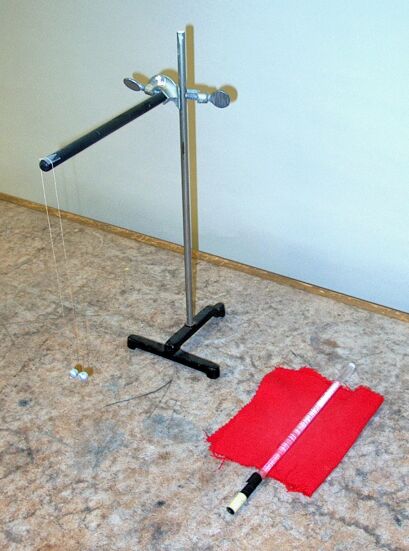
Rub the plastic rod with the red felt. Touch the rod to the pith balls. They splay apart. Also, you will notice that if you bring the rod to one pith ball from the side, the rod attracts it, but as soon as the pith ball touches the rod, it flies away from it.
In demonstration 56.03 – Attract paper bits with charged rod, you charge the rod, and the paper bits cling to the rod. The bits of paper are insulators, so they cannot conduct charge, but the charges inside the paper have enough mobility that the bits of paper can become polarized by a charged object placed near them. Thus, when you bring the charged rod near the paper bits, the charge distribution in the paper shifts so that charges of the same sign as those on the rod move away from the rod, opposite charges move towards the rod, and the paper bits stick to the rod. A pith ball is a light ball whose surface is coated with a conductive material. (Pith is the spongy material found inside most vascular plants, or other plant tissue that has a similar consistency. Nowadays, most pith balls are probably made of styrofoam or other similar material.) When you bring the charged rod close to a pith ball, initially, you polarize the pith ball, as you would a piece of paper, and the ball approaches the rod. When the pith ball touches the rod, however, because its surface is conductive, charge travels from the rod onto the pith ball, and distributes itself evenly over the whole surface. The ball now has a net charge of the same sign as that on the rod, so it is repelled by the rod and flies away. If it now touches the other pith ball, the second pith ball picks up half the charge (assuming the second pith ball is the same size as the first), and both fly apart. If you touch them both at the same time with the rod, each one picks up charge from the rod, and they both repel the rod and each other, and fly apart.